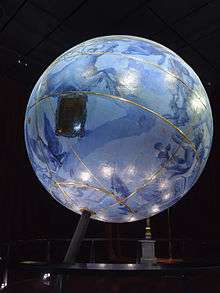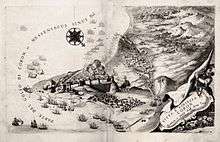Vincenzo Coronelli
| Vincenzo Coronelli | |
|---|---|
|
Vincenzo Coronelli, from the frontispiece of the folio edition of Atlante Veneto | |
| Born |
August 16, 1650 Venice, Republic of Venice |
| Died |
December 9, 1718 (aged 68) Venice, Republic of Venice |
| Occupation | Cartographer, friar, encyclopedist |
| Known for | Paris Globes, Atlante Veneto |
Vincenzo Coronelli (August 16, 1650 – December 9, 1718) was a Franciscan friar, cosmographer, cartographer, publisher, and encyclopedist known in particular for his atlases and globes. He spent most of his life in Venice.
Biography
Vincenzo Coronelli was born, probably in Venice, August 16, 1650, the fifth child of a Venetian tailor named Maffio Coronelli. At ten, young Vincenzo was sent to the city of Ravenna and was apprenticed to a xylographer. In 1663 he was accepted into the Conventual Franciscans, becoming a novice in 1665. At age sixteen he published the first of his one hundred forty separate works. In 1671 he entered the Convent of Saint Maria Gloriosa dei Frari in Venice, and in 1672 Coronelli was sent by the order to the College of Saint Bonaventura and Saints Apostoli in Rome where he earned his doctor’s degree in theology in 1674. He excelled in the study of both astronomy and Euclid. A little before 1678, Coronelli began working as a geographer and was commissioned to make a set of terrestrial and celestial globes for Ranuccio II Farnese, Duke of Parma. Each finely crafted globe was five feet in diameter (c. 175 cm) and so impressed the Duke that he made Coronelli his theologian.[1][2][3][4] Coronelli's renown as a theologian grew and in 1699 he was appointed Father General of the Franciscan order.[5]
Globes for Louis XIV


Cardinal César d'Estrées, friend and adviser to Louis XIV and ambassador to Rome, saw the Duke of Parma’s globes and invited Coronelli to Paris in 1681 to construct a pair of globes for the Most Christian King. Coronelli moved to the French capital in 1681, where he lived for two years. Each globe was composed of spindles of bent timber about ten feet long and four inches broad at the equator. This wood was then coated with a layer of plaster about an inch thick and covered in a layer of strong unfinished fabric. This was then wrapped in a quarter-inch layer of two very fine fabrics which provided backing for the painted information of the globes.[6] These globes, measuring 384 cm in diameter[7] and weighing approximately 2 tons, are displayed in the Bibliothèque nationale François Mitterrand in Paris.[8] The globes depicted the latest information of French explorations in North America, particularly the expeditions of René-Robert Cavelier, Sieur de La Salle.[9]
Later life
Due to his renown he worked in various European countries in the following years, permanently returning to Venice in 1705. In Venice he started his own cosmographical project and published the volumes of Atlante Veneto. In his home city he founded the very first geographical society, the Accademia Cosmografica degli Argonauti. He also held the position of Cosmographer of the Republic of Venice.[10] Later six volumes of the Biblioteca Universale Sacro-Profana were published by Coronelli. This was a kind of encyclopedia, its compiled entries were ordered alphabetically.
Coronelli died at the age of 68 in Venice, having created hundreds of maps in his lifetime. Original globes by Coronelli are today located in several collections. Pairs of his most famous large (c. 110 cm diameter) globes are e.g. in the Biblioteca Marciana in Venice, in the Library Angelo Mai in Bergamo other two globes are now in restoration being part of the FAI project "Save the Globes".
The Bergamo Globes
The request for "Globes" started as a private princely commission from a highdemanding class, mostly concentrated in the northern and central Europe courts. The art of coated cards globes with terrestrial or celestial, handwritten and often finely decorated originated in Italy. Coronelli was among the initiators of this art. The most famous Coronelli ‘s globes are divided into 2 groups: the first one includes the Globes manufactured for Parma’s Duke and for Louis XIV, which are unique for top quality; the second one includes those built since 1688, as result of a well known experience. Indeed, the quality of globes made for Louis XIV created the "request" for other Coronelli's globes. Their reputation was so wide that provoked the request from the highest class and institution, desiring to adorn their libraries with these elements not only for scientific use but also as artistic element. By this intent the two globes that we admire today in the Salone Furietti of Angelo Mai Library arrived in Bergamo. The history of the two globes is closely tied to cultural events and policies that have affected the city of Bergamo in the last 500 years. In fact the two Coronelli globes came to Bergamo in 1692, when Angelo Finardi, man of letter and Augustinian friar was librarian at the St. Augustine monastery. He charged a man to buy them in Venice just with the purpose of equipping the monastery library with essential tools to culture. In 1797, the St. Augustine monastery was suppressed, both the globes met with the confiscations of Napoleonic laws and were on the way to be brought to Paris and gathered with the Versailles globes. Nevertheless, thanks to the noble Giovanni Battista Vertova who hidden the two globes in his home in 1834 they were donated by his son Andrea to the Bergamo Library. Other globes are at the National Library of Austria and in the Globe Museum in Vienna, in the library of Stift Melk, as well as in Trier, Prague, Paris, London, Washington D.C.. Having been restored and completed, another 1688 terrestrial globe is displayed at the Southwest Collection/Special Collections Library of Texas Tech University in Lubbock, Texas. The Ransom Center at The University of Texas in Austin has a pair of Coronelli globes both the 1688 Terrestrial and the Celestial (n.d.).
The International Coronelli Society for the Study of Globes, founded 1952 in Vienna, is named in Coronelli's honor.
Selected maps

- 1690-91 Atlante Veneto
- 1696-97 Isolario dell' Atlante Veneto
- 1692 Corso geografico universale
- 1695 Re-issued
- 1693 Epitome Cosmografica
- 1693 Libro dei Globi
- 1701 Re-issued
- 1695 World Map
- 1696 Pacific Ocean
Partial bibliography
- Morea, Negroponte & Adiacenze (1686).
- Atlante Veneto (1691 - 1696).
- Ritratti de celebri Personaggi (1697).
- Lo Specchio del Mare (1698).
- Singolarità di Venezia (1708-1709).
- Roma antico-moderna (1716).
References
- ↑ “Le Hall des Globes: Exposition permanente des Globes de Coronelli à la BnF,” press release, (Paris: Bibliothèque nationale de France, 2006), 6-7.
- ↑ Coronelli, Vincenzo (1693). Libro dei Globi. Venice. pp. v.
- ↑ James Lawrence Fuchs, “Vincenzo Coronelli and the Organization of Knowledge: The Twilight of Seventeenth-Century Encyclopedism” (Ph.D. dissertation, University of Chicago, 1983), 4-7.
- ↑ Ermano Armao, Vincenzo Coronelli, Cenni Sull’uomo e la Sua Vita (Firenze: Bibliopolis, 1944), 1-16ff.
- ↑ Old Church Galleries
- ↑ Monique Pelletier, “Les Globes de Louis XIV: les Sources françaises de l’oeuvre de Coronelli,” Imago Mundi 34 (1982): 78.
- ↑ The diameter is of 487 cm with meridians and horizon circles.
- ↑ Monique Pelletier, “Les Globes de Louis XIV: les Sources françaises de l’oeuvre de Coronelli,” Imago Mundi 34 (1982): 78.
- ↑ Tucker, Gene Rhea (2008). "Coronelli's Texan Mississippi: A Reinterpretation of the America Settentrionale of 1688". Terrae Incognitae. 40: 82–101.
- ↑ Anastasia Stouraiti, "Propaganda figurata: geometrie di dominio e ideologie veneziane nelle carte di Vincenzo Coronelli", Studi veneziani 44 (2002), 129-155
External links
| Wikimedia Commons has media related to Vincenzo Coronelli. |
- Les globes du Roi Soleil, exposition de la BNF
- Hall des Globes (bibliothèque nationale de France)
- List of the works of Vincenzo Coronelli (1650-1718) at the Marciana National Library, Venice
- Picture of one of Coronelli's maps of the Koron fortress, Greece, excellent quality
- Reconstructions of the globes of Vincenzo Coronelli
- Original technology 42 " diam. Coronelli globe
- Pictures of facsimiles of Coronelli's 1688 & 1693 terrestrial and celestial globes
- Six plates from Coronelli's Epirome cosmografica of 1693: facsimiles of his only flat printed maps, at Linda Hall Library.
- High resolution 3D visualization of the Louis XIV globes made by the C2RMF
- Sphère céleste, 1688
- Sphère terrestre, 1688